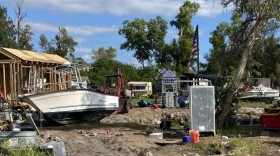Five years ago, Hurricane Irma devastated sections of the mangrove forests surrounding Pine Island that had already suffered damage from previous storms.
Last summer volunteers organized by the Sanibel-Captiva Conservation Foundation replanted more than 3,500 little mangrove trees, and more than three-fourths of the propagules took hold and many have since grown a foot taller.
“This is a great sign that the damaged island could soon be restored to its original mangrove cover,” said Kealy McNeal, SCCF’s community conservation coordinator. “This is the first sign of successful restoration.”
The planted mangroves are already bearing new green leaves, which provide shade for the tiny creatures in the water below and food for things like the aptly-named mangrove tree cra on branches above. Horseshoe crabs scavenge at the bottom of mangroves to feed on algae, invertebrates, and dead stuff.
Mangrove forests contribute to long-term stability of the nearshore ecosystem, and act as an important fish nursery with shallow water underneath and a lot of long roots in which to hide if a predator can get in.
More than 60 volunteers joined SCCF staff to plant the 3,500 red mangroves in an area once covered by mangroves but had been stripped bare by storms.
Volunteers also helped haul in 27,960 pounds of shell to create more surface area in the water to promote oyster growth. Oyster reefs along the edge of mangrove islands form a barrier from high wave action that may interfere with the growth of mangrove forests.
“We have noticed during our surveys that juvenile fish are seeking refuge in the newly planted areas when they are underwater with the tides,” McNeal said. “They still have a lot of growing to do in order for other wildlife to take advantage.”
A vast majority of the country’s mangrove forests are within the Florida Everglades, where the plants are whipped by tropical storms as strong as Category 4 Charley in 2004, Category 3 Hurricane Irma in 2017, or even the weak Potential Tropical Cyclone One in May 2022.
The strong winds strip off the leaf canopy from many of the trees, while the storm surge can damage the tree up high where the churning water can damage mangroves and result in changes in the coastline.
SCCF is seeking volunteers for its next mangrove replanting In September. If interested, call McNeal at 239-472-8585, ext. 2300.
Environmental reporting for WGCU is funded in part by VoLo Foundation, a non-profit with a mission to accelerate change and global impact by supporting science-based climate solutions, enhancing education, and improving health.
Sign up for WGCU's monthly environmental newsletter, the Green Flash, today.








